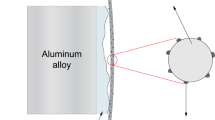Abstract
In traditional electroforming process for revolving parts with complex profiles, the drawbacks on surface of deposits, such as pinholes and nodules, will lead to varying physical and mechanical properties on different parts of electroformed components. To solve the problem, compositely moving cathode is employed in abrasive-assisted electroforming of revolving parts with complicated profiles. The cathode translates and rotates simultaneously to achieve uniform friction effect on deposits without drawbacks. The influences of current density and translation speed on the microstructure and properties of the electroformed nickel layers are investigated. It is found that abrasive-assisted electroforming with compound cathode motion can effectively remove the pinholes and nodules, positively affect the crystal nucleation, and refine the grains of layer. The increase of current density will lead to coarse microstructure and lower micro hardness, from 325 HV down to 189 HV. While, faster translational linear speed produces better surface quality and higher micro hardness, from 236 HV up to 283 HV. The weld-ability of the electroformed layers are also studied through the metallurgical analysis of welded joints between nickel layer and 304 stainless steel. The electrodeposited nickel layer shows fine performance in welding. The novel compound motion of cathode promotes the mechanical properties and refines the microstructure of deposited layer.








Similar content being viewed by others
References
BROUSSEAU E B, DIMOV S.S., PHAM D T. Some recent advances in multi-material micro-and nano-manufacturing[J]. The International Journal of Advanced Manufacturing Technology, 2010, 47(1–4): 161–180.
QU Ningsong, QIAN Wanghuan, HU Xiaoyun, et al. Preparation of a microprism Ni-CeO2 nanocomposite mold by electroforming[J]. Materials & Manufacturing Processes, 2014, volume 29(1): 37–41.
HUANG MingShyan, KU HongHua. Microinjection molding of light-guided plates using LIGA-like fabricated stampers[J]. Journal of Applied Polymer Science, 2011, 122(5): 3446–3455.
LARSON C, SMITH J R. Recent trends in metal alloy electrolytic and electroless plating research: a review[J]. Transactions of the IMF, 2011, 89(6): 333–341.
ZHONG Z W. Recent advances in polishing of advanced materials[J]. Materials and Manufacturing Processes, 2008, 23(5): 449–456.
MING Pingmei, ZHU Di, HU Yangyang, et al. Numericall analysis on mass transport in micro electroforming of micro structures with high-aspect-ratio[J]. Chinese Journal of Mechanical Engineering, 2008, 44(8): 195–201. (in Chinese).
QIAN Jiangang, LI Haiting, LI Pengrui. Effect of technology parameters on microstructure and properties of electroforming nickel layer[J]. Rare Metal Materials and Engineering, 2015, 44(7): 1758–1762. (in Chinese).
WENG Can, ZHOU Mingyong, JIANG Bingyan, et al. Improvement on replication quality of electroformed nickel mold inserts with micro/nano-structures[J]. International Communications in Heat & Mass Transfer, 2016, 75: 92–99.
LIU Gang, TIAN Yangchao. Research and application of LIGA process at national synchrotron radiation laboratory[J]. Chinese Journal of Mechanical Engineering, 2008, 44(11): 47–52. (in Chinese).
ZHU Zengwei, ZHU Di, QU Ningsong. Effects of simultaneous polishing on electrodeposited nanocrystalline nickel[J]. Materials Science and Engineering: A, 2011,528 (24): 7461–7464.
ZHU Di, ZHU Zengwei, QU Ningsong: Abrasive polishing assisted nickel electroforming process[J]. CIRP Annals Manufacturing Technology, 2006, 55(7): 193–196.
MIMANI T, MAYANNA S M, MUNICHANDRAIAH N. Influence of additives on the electrodeposition of nickel from a Watts bath: a cyclic voltammetric study[J]. Journal of Applied Electrochemistry, 1993, 23(4): 339–345.
OLIVEIRA E M, FINAZZI G A, CARLOS I A. Influence of glycerol, mannitol and sorbitol on electrodeposition of nickel from a Watts bath and on the nickel film morphology[J]. Surface and Coatings Technology, 2006, 200(20): 5978–5985.
DINI J W, JOHNSON H R, SAXTON H J. Influence of sulfur content on the impact strength of electroformed nickel[J]. Electrodeposition and Surface Treatment, 1974, 2(3): 165–176.
BROOKS J A, DINI J W, JOHNSON H R. Effects of impurities on the weldability of electroformed nickel[J]. SAND 78–8774, US Sandia Laboratories, 1978.
DINI J W, JOHNSON H R. High-temperature ductility of electro-deposited nickel[J]. Sandia Laboratories SAND 77–8020, July, 1977.
TIAN Zongjun, WANG Gguifeng, HUANG Yinhui, et al. Rapid prototyping of nickel metal products via jet electrodeposition[J]. Huanan Ligong Daxue Xuebao/Journal of South China University of Technology, 2010, 38(12): 41–44. (in Chinese).
ZHAO Jianfegn, HUANG Yinhui, WU Ande. Fundamental experimental study on selective electrodeposition rapid prototyping with electrolyte jet[J]. Chinese Journal of Mechanical Engineering, 2003, 39(4): 75–78. (in Chinese).
LEI Weining, ZHU Di, QU Ningsong. Research on mechanical properties of nanocrystalline electroforming layer[J]. Chinese Journal of Mechanical Engineering, 2004, 40(12): 124–127. (in Chinese).
XUE Yujun, LIU Hongbin, LAN Mingming, et al. High temperature oxidation resistance of Ni-CeO2 nanocomposite coatings by pulse electrodeposition under ultrasound condition[J]. Zhongguo Youse Jinshu Xuebao/Chinese Journal of Nonferrous Metals, 2010, 20(8): 1599–1604. (in Chinese).
ZHU Zengwei, WANG Dong, REN Jianhua. Abrasive-assisted electroforming of nickel on translational cathode[C]//Materials Science Forum. Trans Tech Publications, 2014, 770: 145–149.
LI Xuelei, ZHU Zengwei, ZHU Di, et al. Orbital-abrasion-assisted electroforming of non-rotating parts[J]. Journal of Wuhan University of Technology-Mater, 2011, 26(5): 827–831.
LI Xuelei., ZHU Di, ZHU Zengwei. Effect of free particles to the abrasion-assisted electroforming technique[J]. Electromachining & Mould, 2010: 35–39. (in Chinese).
BROOKS J A, DINI J W, JOHNSON H R. Causes of weld porosity in electroformed nickel[J]. Metal Finishing, 1981, 75(5): 41–45.
LU Anli, REN Jialie., LU Baocai, et al. The investigation on welding cracks of electroformed nickel of aero-space components[J]. Missiles & Space Vehicles, 1993,3: 65–74. (in Chinese).
ZHANG, Ling, MIN Junying, WANG bin,et al. Constitutive model of friction stir weld with consideration of its inhomogeneous mechanical properties[J]. Chinese Journal of Mechanical Engineering, 2016, 29(2):357–364.
Author information
Authors and Affiliations
Corresponding author
Additional information
Supported by National Natural Science Foundation of China (Grant No. 51475239) and Program for New Century Excellent Talents in University of China (Grand No. NCET-10-0074).
Rights and permissions
About this article
Cite this article
REN, J., ZHU, Z., XIA, C. et al. Abrasive-assisted Nickel Electroforming Process with Moving Cathode. Chin. J. Mech. Eng. 30, 294–300 (2017). https://doi.org/10.1007/s10033-017-0078-4
Received:
Revised:
Accepted:
Published:
Issue Date:
DOI: https://doi.org/10.1007/s10033-017-0078-4




